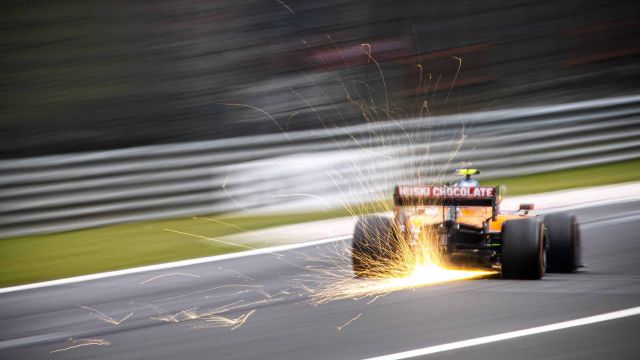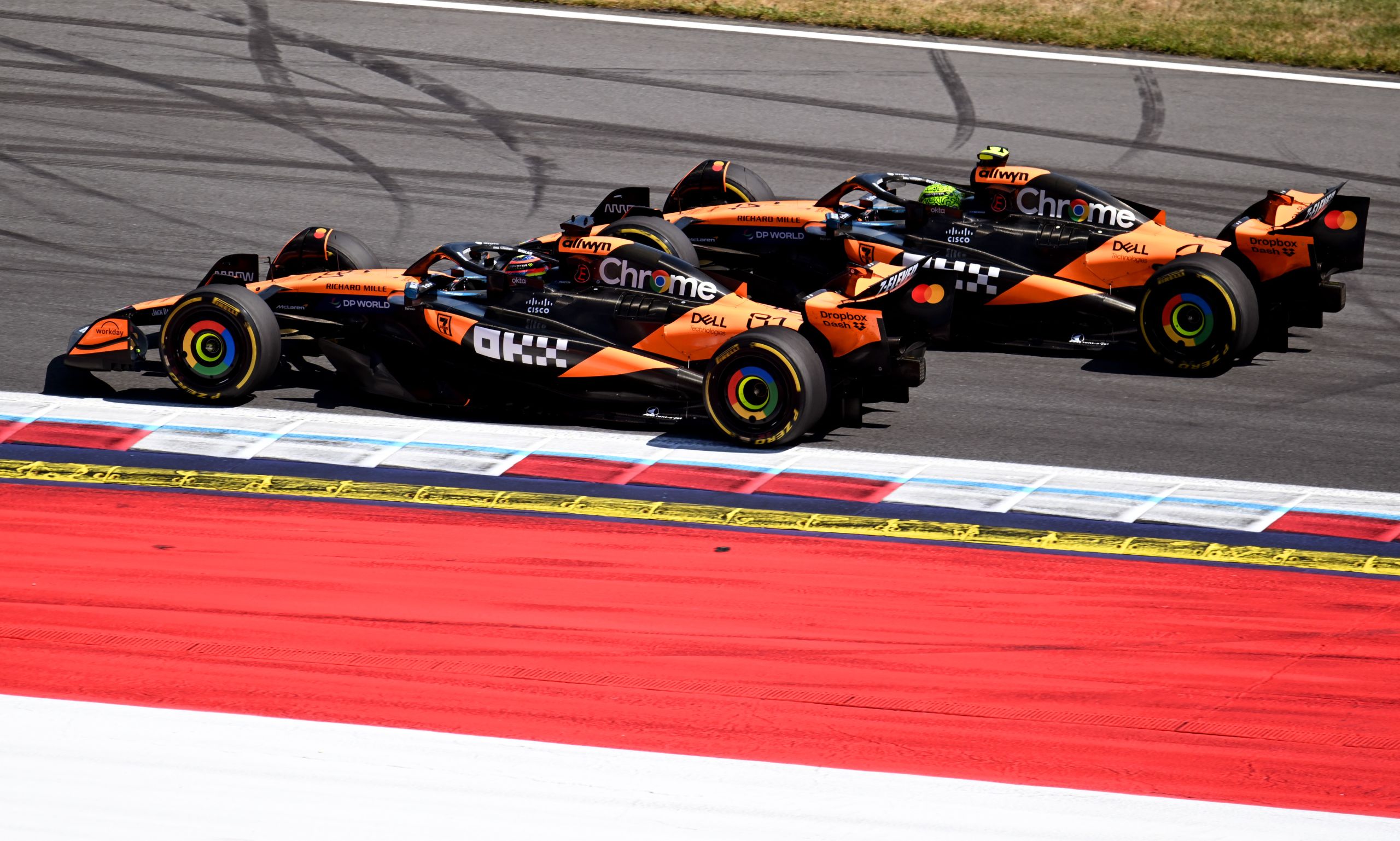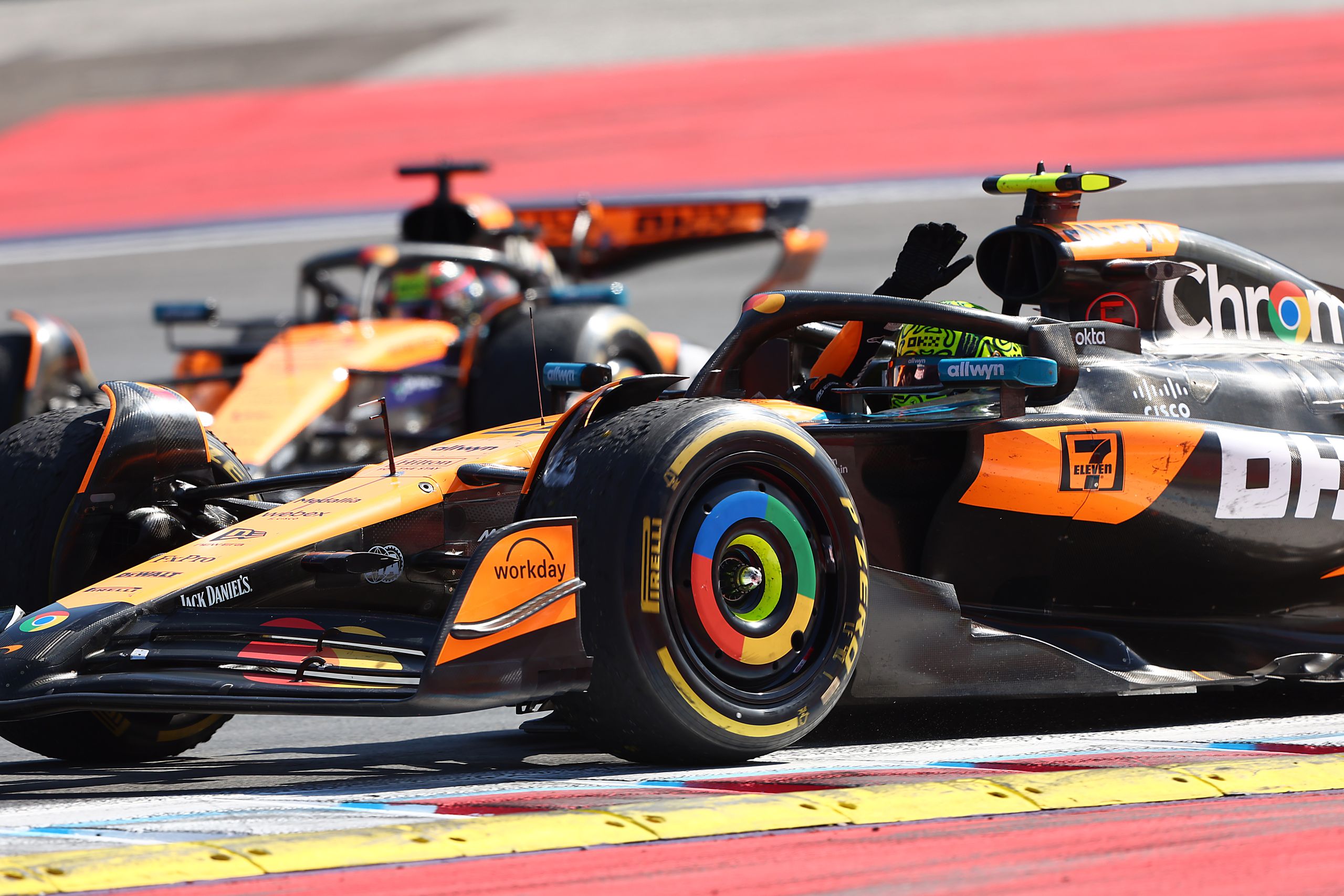What Is Ride Height In F1?


In Formula 1, ride height is the distance between the car’s floor and the track surface. This seemingly simple measurement plays a crucial role in a car’s performance, influencing both its aerodynamic efficiency and mechanical grip. A lower ride height brings the car’s center of gravity closer to the ground, enhancing stability, cornering speeds, and braking response. Conversely, raising the ride height provides more ground clearance, which is crucial on uneven tracks like Monaco.
Modern F1 cars rely heavily on aerodynamic downforce to maintain high speeds through corners. The underfloor of the car creates a ground effect, channeling air to generate significant downforce. However, this effect is highly sensitive to ride height. A lower ride height increases downforce, while raising it reduces aerodynamic grip.
The ride height also affects the car’s mechanical grip:
- Lower Ride Height:
- Reduces the car’s center of gravity, improving stability and minimizing body roll.
- Enhances grip due to increased downforce.
- Higher Ride Height:
- Increases suspension travel, allowing the car to handle bumps better.
- Reduces overall downforce, decreasing mechanical grip.
Formula 1 teams face a delicate balancing act when tuning the ride height. Too low, and the car risks bottoming out, negatively affecting performance and causing potential damage. Too high, and it loses valuable downforce and grip.
In wet conditions, teams raise the ride height to prevent the car from aquaplaning. This allows water to pass freely under the floor, preventing the car from “floating” on a layer of water.
The difference in ride height between the front and rear of the car is known as the rake angle:
- Positive Rake: Higher rear ride height shifts weight forward, improving braking response and cornering stability.
- Equal Front and Rear Ride Height: Distributes weight evenly.
- Negative Rake: Higher front ride height is generally not used in racing.
Optimizing ride height in Formula 1 involves finding the perfect balance between downforce, mechanical grip, and suspension travel. Teams carefully tune this parameter to maximize performance based on track conditions and race strategy. Understanding and mastering ride height is a critical part of delivering a championship-winning car.
Formula 1 car ride height explained
When a race car is experiencing an enormous amount of down-force, the ride height changes constantly. When the car goes fast, aerodynamic forces act on the vehicle in such a way that it is forced downward.
Therefore, the actual ride height is governed by the aerodynamic forces working against the vehicle at any given time. Simply put, the ideal ride height depends on the speed of the vehicle. So, the challenge facing the race car engineer is to set the ride height as close to ideal as possible for all conditions.
The static ride height can be modified by extending the length of the suspension’s pushrods using spacers, or shims. Normally, the suspension rods are only extended by a half millimetre at a time. The typical Formula 1 car runs with a static front ride height of 30 to 35 millimetres and a rear static ride height of 75 to 80 millimetres.
The dynamic ride height, on the other hand, is determined by the stiffness of the suspension spring (the stiffer the springs, the more resistant they are to downforce) and the tire pressure because increased tire pressure makes the tires more rigid. Stiffer springs and higher tire pressure work together to create greater dynamic ride heights.
But running the car as low as possible is not necessarily true for the whole car. The front end of the vehicle does need to be as low as possible, but the rear usually has a higher ground clearance. This allows the underbody aerodynamics to work better. The difference between the front and rear ride heights is known as the rake. Ideally, the race car performs better with positive rake.
F1 Ride Height Technical Aspects
The technical aspects of ride height in Formula 1 revolve around the intricate interplay between aerodynamics, mechanical grip, and suspension travel. Here’s a breakdown of these elements:
Ground Effect
- Ground effect is the aerodynamic principle that maximizes downforce by channeling airflow beneath the car.
- A lower ride height enhances this effect by creating a tighter seal between the car’s floor and the track, increasing the velocity of air passing through and generating significant downforce.
- However, the ground effect is highly sensitive to changes in ride height. A minor increase in clearance can drastically reduce downforce, causing a loss of grip.
Aerodynamics
- Downforce Generation:
- The underfloor and diffuser of an F1 car are designed to maximize downforce when the ride height is low.
- However, if the car bottoms out, the airflow under the car becomes turbulent, reducing downforce and affecting stability.
- Drag Reduction:
- A lower ride height also minimizes aerodynamic drag, improving straight-line speed.
- Conversely, a higher ride height increases drag due to less efficient airflow under the car.
Mechanical Grip
- Suspension Systems:
- The pushrod or pullrod suspension system helps maintain optimal mechanical grip by keeping the tires in contact with the track.
- Hydraulic systems further stabilize the car and prevent excessive body roll.
- Weight Distribution:
- Lowering the ride height shifts the car’s center of gravity downward, improving cornering speeds and braking stability.
- Positive rake (higher rear than front) shifts weight forward, providing more grip to the front tires for better cornering.
Porpoising
- Porpoising refers to the violent oscillation of a car due to fluctuating aerodynamic forces.
- When the car is too low, airflow under the floor becomes disrupted, causing a sudden loss of downforce and making the car “bounce” on the track.
- Teams carefully adjust ride height and suspension stiffness to minimize this phenomenon.
Suspension Travel
- Ride height directly affects the available suspension travel.
- If the ride height is too low, the suspension may bottom out, preventing it from effectively absorbing bumps and negatively impacting tire grip.
- Engineers balance ride height with spring stiffness to ensure sufficient travel while maintaining aerodynamic performance.
Ride Height Regulations Overview
The FIA (Fédération Internationale de l’Automobile) strictly regulates ride height in Formula 1 to ensure fairness and safety. These rules have evolved over the years, reflecting changing aerodynamic and safety considerations.
Current FIA Regulations
- Plank Thickness:
- All Formula 1 cars are required to have a plank made of a wood-like material (commonly called the ‘skid block’) attached to the underside of the car.
- The plank must have a minimum thickness of 10 mm.
- Excessive wear, reducing the plank thickness by more than 1 mm, results in disqualification.
- Ride Height Measurement:
- The ride height is checked post-race by measuring the plank thickness at specific points.
- Teams use ‘skid blocks’ or titanium skid plates to minimize plank wear and prevent excessive reduction in thickness.
Ride Height Tuning Limitations
- Parc Fermé Conditions:
- After qualifying, teams must submit their cars to parc fermé conditions, restricting ride height adjustments until after the race.
- Only minor suspension changes are permitted in response to weather changes.
- Technical Directives:
- Technical directives issued by the FIA may enforce stricter ride height controls if any team is suspected of circumventing the rules.
Aerodynamic Testing Restrictions
- Wind Tunnel Testing:
- Teams are limited to a set number of wind tunnel hours per season, making it challenging to perfect ride height optimization.
- CFD (Computational Fluid Dynamics):
- Restrictions also apply to the number of CFD simulations allowed.
- These limitations encourage teams to use their resources strategically to improve ride height aerodynamics.
Active Suspension Ban
- Active suspension systems, which automatically adjusted ride height based on conditions, were banned in the 1994 season.
- Teams now rely on passive suspension systems, making ride height tuning a manual and strategic task.
Ground Effect Era Regulations (2022 and Beyond)
- The 2022 regulations reintroduced ground effect aerodynamics, emphasizing underfloor airflow.
- This change makes ride height even more critical:
- Diffuser Tunnel Size: The size of the diffuser tunnels under the floor is strictly controlled to prevent excessive downforce generation.
- Flexibility Testing: Floor flexibility is tested to prevent teams from using flexible floors to manipulate ride height.
Formula 1 Ride Height FAQs
What causes uneven ride height?
The relationship between ride height and aerodynamics is an intricate one. Racecar engineers use an aerodynamic map to show how downforce works against the aerodynamic contours of the vehicle in a variety of combinations to determine the optimum ride height. They then use their findings to set the vehicle’s rake accordingly.
If they fail to find the optimum downforce ratio between the front and rear of the vehicle, performance will suffer. If the downforce hits the car in a way that is not conducive to aerodynamic balance, it will affect steering, making the car hard to handle.
Active ride height differs from both static ride height and dynamic ride height in that its objective is to keep the ride height the same under all race conditions, yet with a suspension that is hardy enough to absorb any bumps in the track it may encounter.
When it senses an aerodynamic load influencing the body, like in downforce, the suspension automatically stiffens to accommodate the pressure. But when the wheels signal the approach of bumps in the roadway, the suspension relaxes. This multiple-personality characteristic of this suspension system gives the driver the best of both worlds in one.
The main purpose of the suspension is not to ensure a smooth ride, however, but to attach the vehicle to its wheels. This might sound like a small matter, but the process involves weaving together several different systems to safely move a heavy object like a race car down the track at tremendous speeds.
How does ride height affect handling?
On a regular automobile, the suspension system has two primary functions – manoeuvrability and ride. Here, ride refers to the way the car deals with different road conditions, how it handles bumps, potholes, curbs, and other changes in the road surface. The suspension absorbs energy created by the vehicle when driving over rough surfaces and dissipates it evenly between the four wheels. Handling, on the other hand, refers to how the vehicle reacts to commands from the driver, like during braking and turning.
Formula 1 suspensions perform the same tasks, although the criteria are slightly different. Take comfort for example. This is an important quality in regular automobiles, but not so much in Formula 1 racing.
Although ride and handling are the primary functions of both Formula 1 and road cars, Formula 1 cars are tasked with a third function – aerodynamics. Or more precisely, to use aerodynamics to create downforce. This is referred to in engineering parlance as platform control. Meaning, the faster the race car goes, the more downforce it creates.
When a race car is travelling at high speeds, the downforce it creates is several times greater than its body weight. Therefore, the Formula 1 suspension must be able to handle tons of extra weight when the car is speeding around the track. So engineers are faced with the huge challenge of making the suspension durable enough to take the extra weight and making it aerodynamic.
The position of the suspension relative to the track is extremely important for the aerodynamic concept to work. Raising or lowering the vehicle by a few millimetres can drastically change the airflow, reducing the effectiveness of aerodynamic parts like the diffuser. So, the engineer must ensure that the Formula 1 suspension rake and ride height be fine-tuned so that the vehicle’s aerodynamics can perform at its fullest potential.
Formula 1 suspension’s elements are also similar in concept to those of a regular automobile, so the springs on all four corners work independently. The elements that make up a Formula 1 car’s suspension can be put into three groups: inboard suspension, outboard suspension, and airflow. Obscured by the body of the Formula 1 car are the suspension’s inboard elements, springs, dampers, rockers, and anti-roll bars. The suspension’s inboard elements link to other elements in the airflow: pull rods, push rods, track rods, and wishbones. These elements are linked to the outboard elements which are tucked away behind the wheels – uptights, axels, and bearings.
How does ride height affect aerodynamics in Formula 1?
Ride height plays a crucial role in generating aerodynamic downforce. A lower ride height enhances the ground effect, improving airflow under the car and increasing downforce. However, this effect is highly sensitive to ride height changes. A small increase in clearance can significantly reduce downforce and grip, while a lower ride height can cause the car to bottom out on uneven surfaces.
What is the optimal ride height setup for different track conditions?
The optimal ride height depends on the track’s surface and weather conditions:
- Smooth Tracks: A lower ride height maximizes downforce and grip, especially on smooth tracks.
- Bumpy Tracks (e.g., Monaco): A higher ride height is needed to prevent bottoming out and absorb bumps.
- Wet Conditions: Increased ride height prevents the car from aquaplaning by allowing water to flow freely under the car.
How do Formula 1 teams adjust ride height during a race weekend?
Teams adjust ride height using suspension components and aerodynamic settings:
- Suspension: Adjusting spring rates and dampers modifies the suspension travel and stiffness.
- Aerodynamics: Front and rear wing angles can be adjusted to complement ride height settings.
- Parc Fermé Rules: Once qualifying ends, ride height adjustments are restricted to minor changes unless authorized by the FIA.
What is porpoising, and how does it relate to ride height?
Porpoising is a phenomenon where the car oscillates violently due to fluctuating aerodynamic forces. It occurs when the car’s ride height is too low, disrupting the airflow under the floor and causing a sudden loss of downforce. Teams mitigate porpoising by carefully adjusting ride height and suspension stiffness.
How does ride height impact mechanical grip in Formula 1 cars?
Ride height influences mechanical grip through weight distribution and suspension travel:
- Lower Ride Height:
- Lowers the car’s center of gravity, enhancing stability and reducing body roll.
- Increases tire grip due to higher downforce.
- Higher Ride Height:
- Provides more suspension travel for absorbing bumps.
- Reduces overall downforce, resulting in lower mechanical grip.
What is the rake angle, and how does it affect ride height?
Rake angle refers to the difference in ride height between the front and rear of the car:
- Positive Rake: Higher rear ride height shifts weight forward, improving cornering stability and braking response.
- Equal Front and Rear Ride Height: Distributes weight evenly across the car.
- Negative Rake: Higher front ride height is generally not used due to its adverse effects on handling.
How do FIA regulations control ride height in Formula 1?
The FIA regulates ride height primarily through plank thickness and technical inspections:
- Plank Thickness: The skid block (plank) must have a minimum thickness of 10 mm. Excessive wear beyond 1 mm leads to disqualification.
- Technical Directives: Restrict teams from manipulating ride height through flexible floors or active suspension systems.
- Parc Fermé Rules: Limit ride height adjustments after qualifying.
What innovations have teams developed to optimize ride height?
Innovations include:
- Hydraulic Suspension Systems: Allow teams to dynamically adjust ride height for improved aerodynamics and mechanical grip.
- Flexible Floors: Some teams use floors that flex at high speeds to lower ride height without violating regulations.
- Aerodynamic Simulations: Wind tunnel and CFD simulations help teams perfect their aerodynamic setup for different ride heights.





